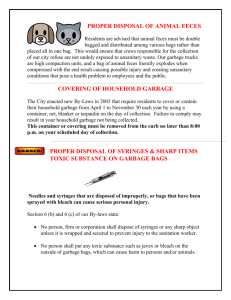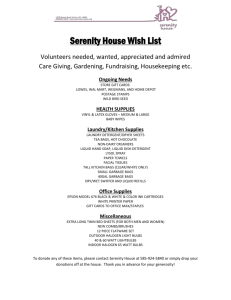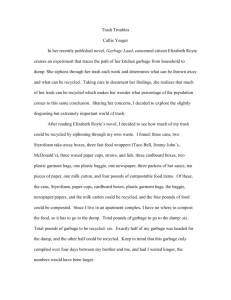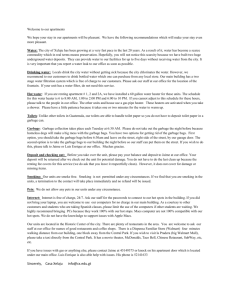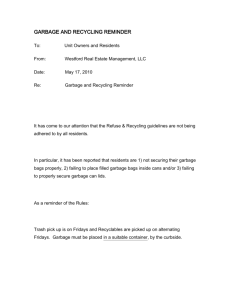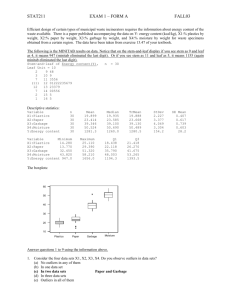TURNING GARBAGE INTO MONEY
advertisement
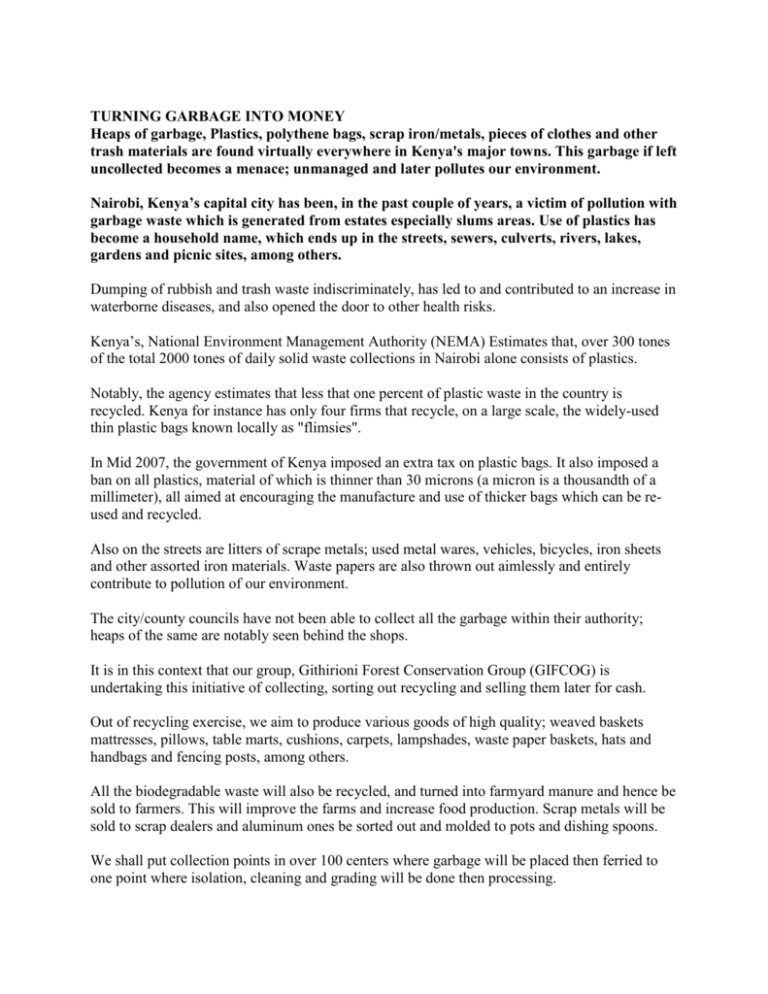
TURNING GARBAGE INTO MONEY Heaps of garbage, Plastics, polythene bags, scrap iron/metals, pieces of clothes and other trash materials are found virtually everywhere in Kenya's major towns. This garbage if left uncollected becomes a menace; unmanaged and later pollutes our environment. Nairobi, Kenya’s capital city has been, in the past couple of years, a victim of pollution with garbage waste which is generated from estates especially slums areas. Use of plastics has become a household name, which ends up in the streets, sewers, culverts, rivers, lakes, gardens and picnic sites, among others. Dumping of rubbish and trash waste indiscriminately, has led to and contributed to an increase in waterborne diseases, and also opened the door to other health risks. Kenya’s, National Environment Management Authority (NEMA) Estimates that, over 300 tones of the total 2000 tones of daily solid waste collections in Nairobi alone consists of plastics. Notably, the agency estimates that less that one percent of plastic waste in the country is recycled. Kenya for instance has only four firms that recycle, on a large scale, the widely-used thin plastic bags known locally as "flimsies". In Mid 2007, the government of Kenya imposed an extra tax on plastic bags. It also imposed a ban on all plastics, material of which is thinner than 30 microns (a micron is a thousandth of a millimeter), all aimed at encouraging the manufacture and use of thicker bags which can be reused and recycled. Also on the streets are litters of scrape metals; used metal wares, vehicles, bicycles, iron sheets and other assorted iron materials. Waste papers are also thrown out aimlessly and entirely contribute to pollution of our environment. The city/county councils have not been able to collect all the garbage within their authority; heaps of the same are notably seen behind the shops. It is in this context that our group, Githirioni Forest Conservation Group (GIFCOG) is undertaking this initiative of collecting, sorting out recycling and selling them later for cash. Out of recycling exercise, we aim to produce various goods of high quality; weaved baskets mattresses, pillows, table marts, cushions, carpets, lampshades, waste paper baskets, hats and handbags and fencing posts, among others. All the biodegradable waste will also be recycled, and turned into farmyard manure and hence be sold to farmers. This will improve the farms and increase food production. Scrap metals will be sold to scrap dealers and aluminum ones be sorted out and molded to pots and dishing spoons. We shall put collection points in over 100 centers where garbage will be placed then ferried to one point where isolation, cleaning and grading will be done then processing. We shall employ 300 youth to take charge of collecting them from various points. We shall use hand pulled carts to transport garbage to the cleaning, sorting and processing center. REQUIREMNTS; No 1 2 3 5 6 7 8 9 10 11 12 13 15 16 Item Hand pulled Carts Waste bin containers Rakes Overalls Shovels Gunny bags Wheel burrows Boiler Plastic grinding machine Molding machine Safety boots Muzzles Press machine Pressurized cleaning machine Quantity 60 200 200 200 200 1000 20 2 1 1 200 200 2 1 Unit cost (US $) 75 38 4 25 25 3 38 6250 5000 7500 38 7 3750 1875 Total Cost(US $) 4,500 7,600 800 500 500 3,000 760 1,2500 5,000 7,500 7,600 1,400 7,500 1,875 61,035


